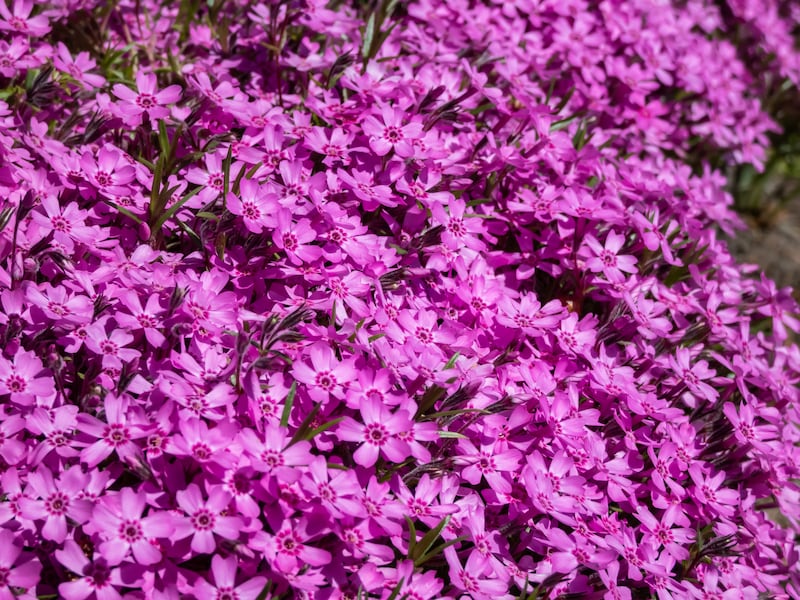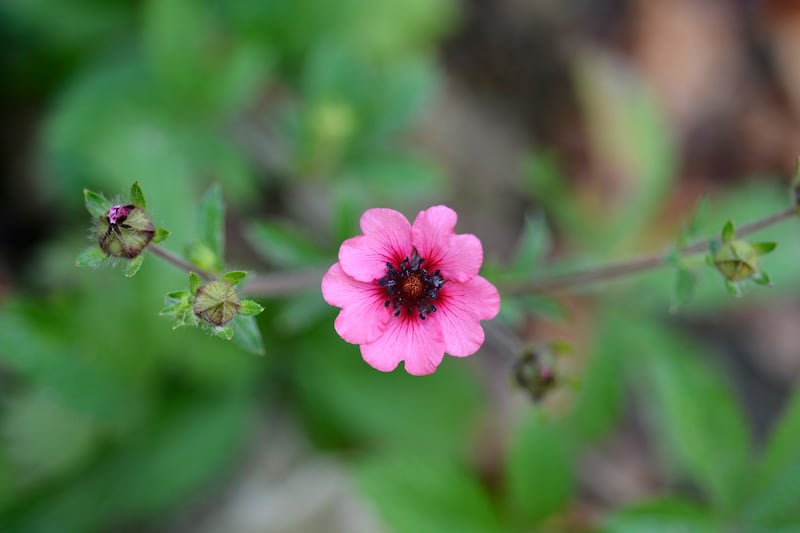As gardeners, most of us are familiar with ramblers and climbers, that hugely diverse group of ornamental plants that we rely upon to clamber decoratively up walls and over trellises, pergolas, gazebos and other decorative garden structures as well as through established trees and shrubs. Much less celebrated but every bit as useful are what I like to call “minglers”, their much smaller equivalents.
If the summer border was a party, these scrambling species are the gregarious guests that love to socialise, making new friends with ease. Indispensable in the flower garden, they’ll prettily thread their way through neighbouring plants, their lax, loose growth habit allowing them to gently weave their stems through a border without ever looking out of place.
Classic examples include varieties of the hardy geranium or cranesbill, many of which are ideal for this purpose. Resilient, reliable and easy to grow, these slug-proof herbaceous perennials form loose, low mounds of foliage from which their flowers appear in profusion in early summer, in some cases for many months.

Geranium “Rozanne”, the violet-blue, exceptionally long-flowering stalwart of many an Irish summer garden, immediately comes to mind, as does its close relative, Geranium “Anne Folkard”, which produces clouds of black-eyed, magenta flowers from June until October. Others — there are so many garden-worthy varieties — include the pale lilac-pink Geranium “Mavis Simpson”, which was first discovered as a chance seedling growing in Kew gardens in the UK, and the lavender — blue and white Geranium wallichianum “Buxton’s Variety”. More compact varieties of perennial geranium that behave similarly include the purple-pink flowering Geranium cinereum “Ballerina”, lipstick-pink Geranium “Ankum’s Pride”; and the diminutive Geranium pyrenaicum “Bill Wallis”. Just be warned that the latter will happily self-seed itself about the place, a trait that can be regarded as a blessing or a curse, depending on your perspective. In my case, I’m looking forward to seeing the plentiful progeny of my young seed-raised plants appear.
Actor Armie Hammer resurfaces as host of celebrity podcast
Heart-stopping Halloween terror: 13 of cinema’s greatest jump scares
Doctor Odyssey’s core message: just imagine Pacey from Dawson’s Creek holding you tight and saying, ‘Shhh, it’s okay’
Conor Niland’s The Racket nominated for William Hill Sports Book of the Year
Herbaceous species of potentilla or cinquefoil perform the same useful role, their low-growing, languidly sprawling growth habit making them easy bedfellows with many other taller species of perennials of a more vertical/upright growth habit such as sanguisorba, linaria and echinacea. In my own garden, I grow the tough, drought-tolerant variety known as Potentilla nepalensis “Melton Fire”, whose pollinator-friendly flowers appear with abundance throughout the summer on very long, low, wiry, branching stems. This easy-going perennial is also very easily raised from seed and is fast to establish sturdy clumps, making it a great choice for a new garden where space needs to be quickly filled.

Its easy-going nature aside, I love it for the brilliance of its flowers, which are an intense shade of bright coral pink that’s counterbalanced by their sooty eyes. Even when viewed from a distance, these provide brilliant droplets of colour on the dreariest of wet summer days.
Other garden-worthy varieties of herbaceous potentilla with flowers in fruity shades include Potentilla “Gibson’s Scarlet”; dark-red Potentilla “Monarch’s Velvet”; the orange-yellow flowering Potentilla “William Rollison”; blood-orange Potentilla “Arc en Ciel”; and the lemon-yellow Potentilla recta var sulphurea. All are long-flowering and happy in full sun or light shade and in most soils bar waterlogged ones. Don’t be put off by the fact that they share the same genus as their somewhat dumpy shrubby relatives. Instead, these herbaceous members of the cinquefoil family are much more akin to geum in terms of their size, flower shape, growth habit and usefulness.
The herbaceous potentilla’s sprawling habit means that it needs space to perform at its best. But for a mingler that will suit a truly tiny garden or a large stone trough or container, seek out creeping phlox, or Phlox douglasii, which forms a super-low mound of semi-evergreen foliage that’s covered with a multitude of small, scented, star-shaped flowers in early summer. Garden-worthy varieties include the pale lilac “Eva” and the white-and-pink “Rosea”. This hardy perennial likes a spot in full sun or light shade, and fertile, moist but free-draining soil.
Another tiny mingler that I wouldn’t be without is Mexican fleabane or Erigeron karvinskianus, a plant so useful that it features in many a garden designer’s top 100. Forming small, low hummocks of fine, semi-evergreen foliage from which a haze of pink-and-white daisy-like flowers appear on slender, wiry, branching stems from spring until the first killing frosts, it’s brilliantly planted to the front of a sunny border or scattered through a gravel garden. Again, it’s a generous self-seeder but never in a way that’s unwelcome. Tiny gaps between paving stones, steps or in old stone walls where its roots are guaranteed sharp drainage are some of its favourite spots, but it will cause no damage. Just make sure to shear the stems back in spring to stop plants from losing the run of themselves.
For something much taller but similar in terms of its airy, elegantly sprawling growth habit and propensity to self-seed, seek out the Macedonian scabious, or Knautia macedonica. Flowering throughout the summer months, this sun-loving herbaceous perennial’s pretty, berry-red, pincushion-shaped flowers appear in profusion on tall, wiry, branching stems and are beloved by pollinators. Planted in the middle or to the back of a sunny, moist but free-draining border where its slim stems can rely on neighbouring plants for some support, it’s guaranteed to add a contemporary touch to any planting scheme. Like the very best minglers, Macedonian scabious also has an almost uncanny ability to mix well with pretty much everything from roses, shrubs and ornamental grasses to modern meadow-style planting, which is the reason why it’s to be found at all the best plant parties having lots of fun with its many friends.
This week in the garden
The heavy rain and strong winds of recent weeks have made for challenging growing conditions for many plants, but especially for summer bedding displays which typically like heat and sunlight to perform at their best. To keep the show on the road, gently comb through plants to remove dead or damaged flowers and leaves and then give them a liquid foliar feed of seaweed which will help to encourage new growth and prevent disease. If container-grown plants are sitting in saucers, make sure to empty these after very heavy rain to help the compost to drain. Where possible, place containers under the cover of overhanging roofs to give them shelter and some respite from the rain.
Crazy as it sounds, now is the time to start making your wish list of spring-flowering bulbs, some of which will need to be ordered in the coming weeks if you want to get your hands on must-have varieties such as Tulip “Apricot Beauty” and Tulip “Belle Epoque”. Although they don’t deliver to Ireland, check out UK-based sarahraven.com and US-based floretflowers.com for inspiration. Both are renowned for their exceptional eye for outstanding varieties.
Dates for your diary
On Saturday, July 22nd, (11am-5pm), Belvedere House Unusual Plant Fair, in Mullingar, Co Westmeath, with plant stalls by many Irish small specialist nurseries and talks by Irish gardeners Jimi Blake of Hunting Brook Gardens and Paul Smyth of RHSI Bellefield, plus music, food and entertainment. See belvedere-house.ie.
From Saturday, July 29th, to Saturday, August 5th, Carlow Garden Festival 2023, with an outstanding line-up of expert and inspiring speakers, including Adam Frost and James Alexander Sinclair at Leighlinbridge Garden Centre (July 29th), Robin Lane Fox at Borris House (August 3rd), Seamus O’Brien at Hardymount Gardens (August 1st), Matthew Wilson and Alys Fowler at Altamont (August 4th), Kitty Scully at Shankill Castle (August 2nd), Nick Bailey at Duckett’s Grove (July 30th), Colm O’Driscoll at Burtown (August 2nd) and Fergus Garrett at Huntington (August 5th). See carlowgardentrail.com. Pre-booking is essential.






